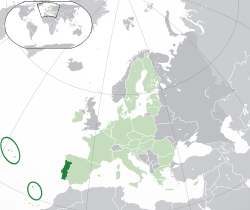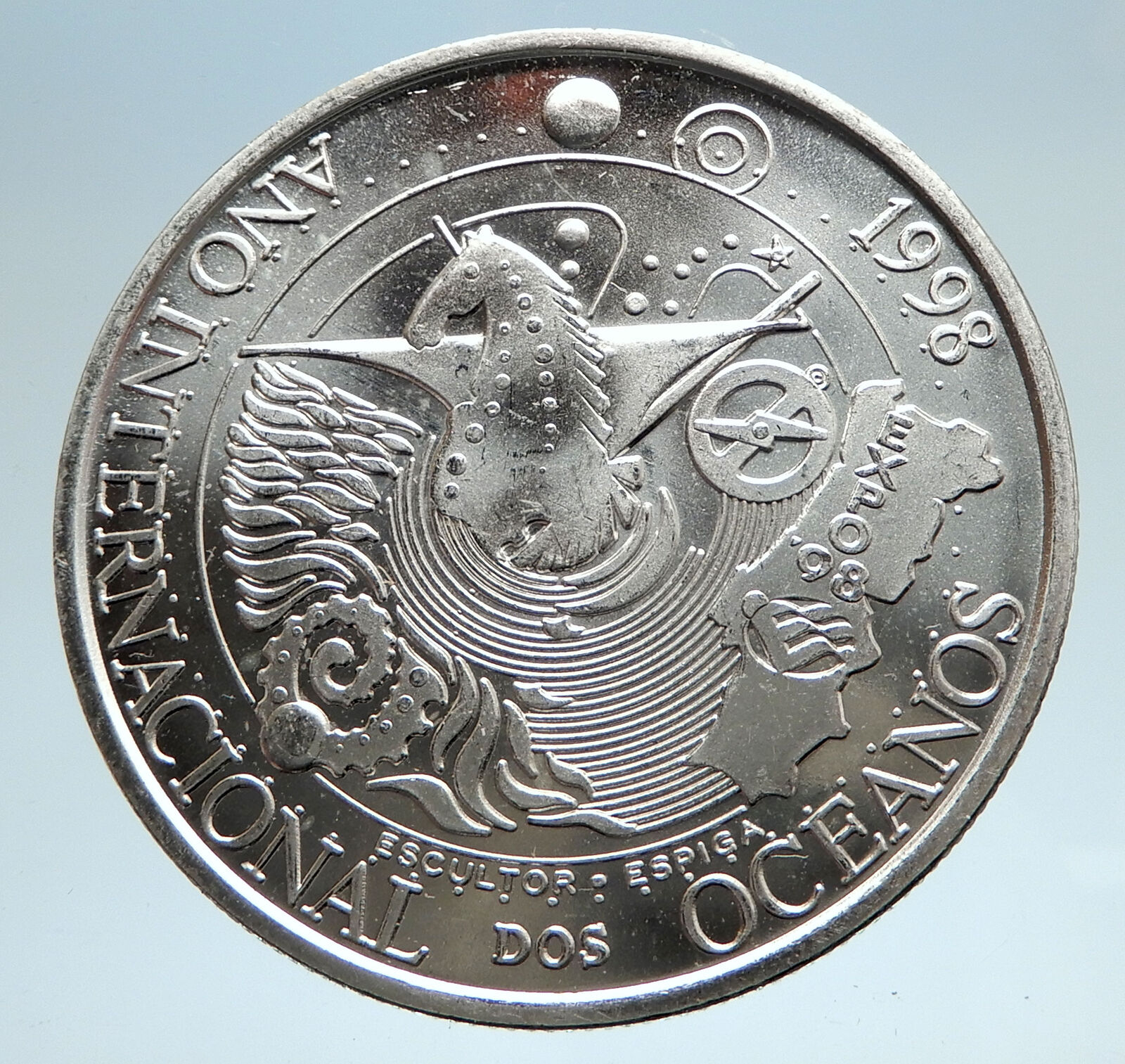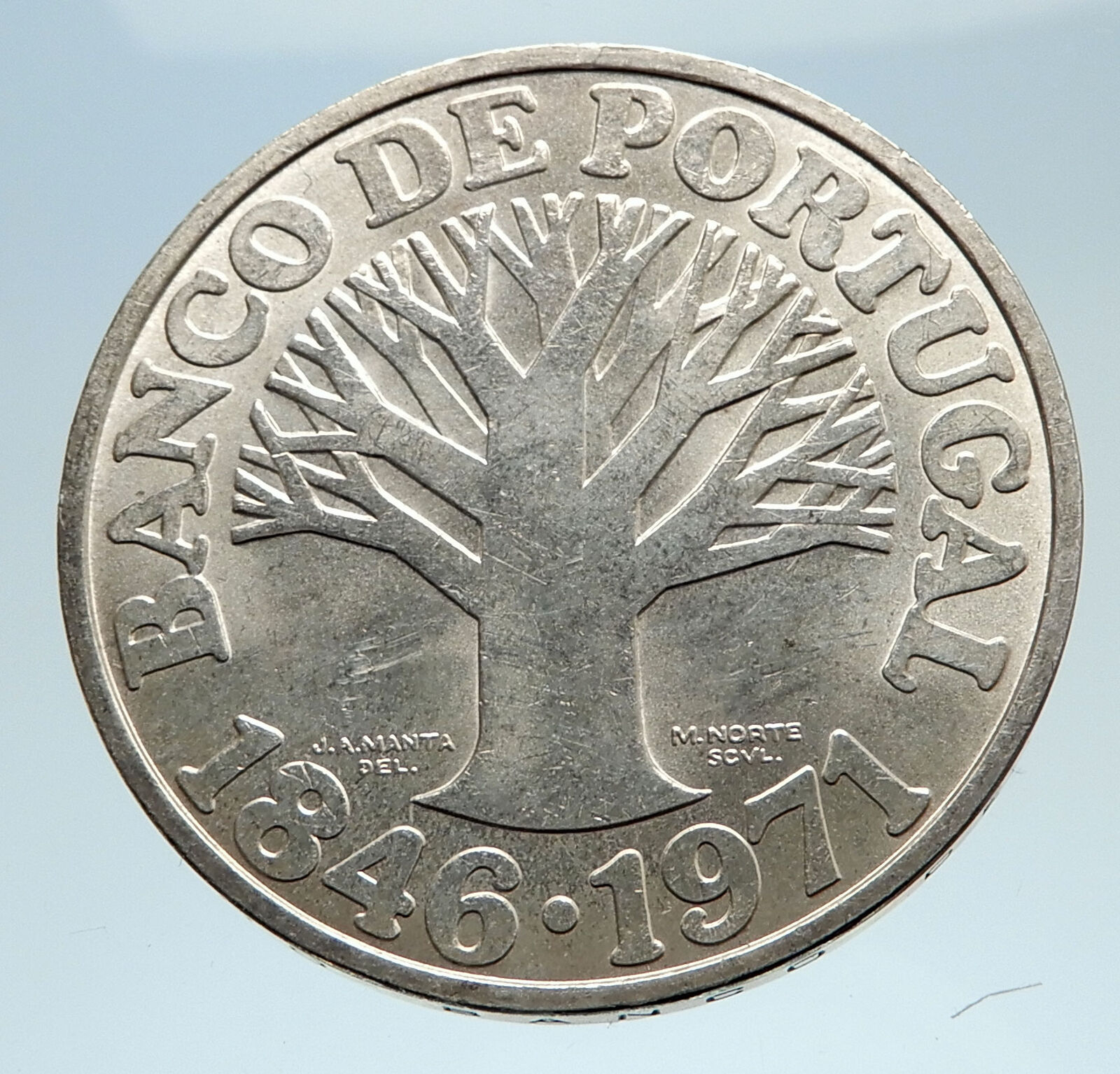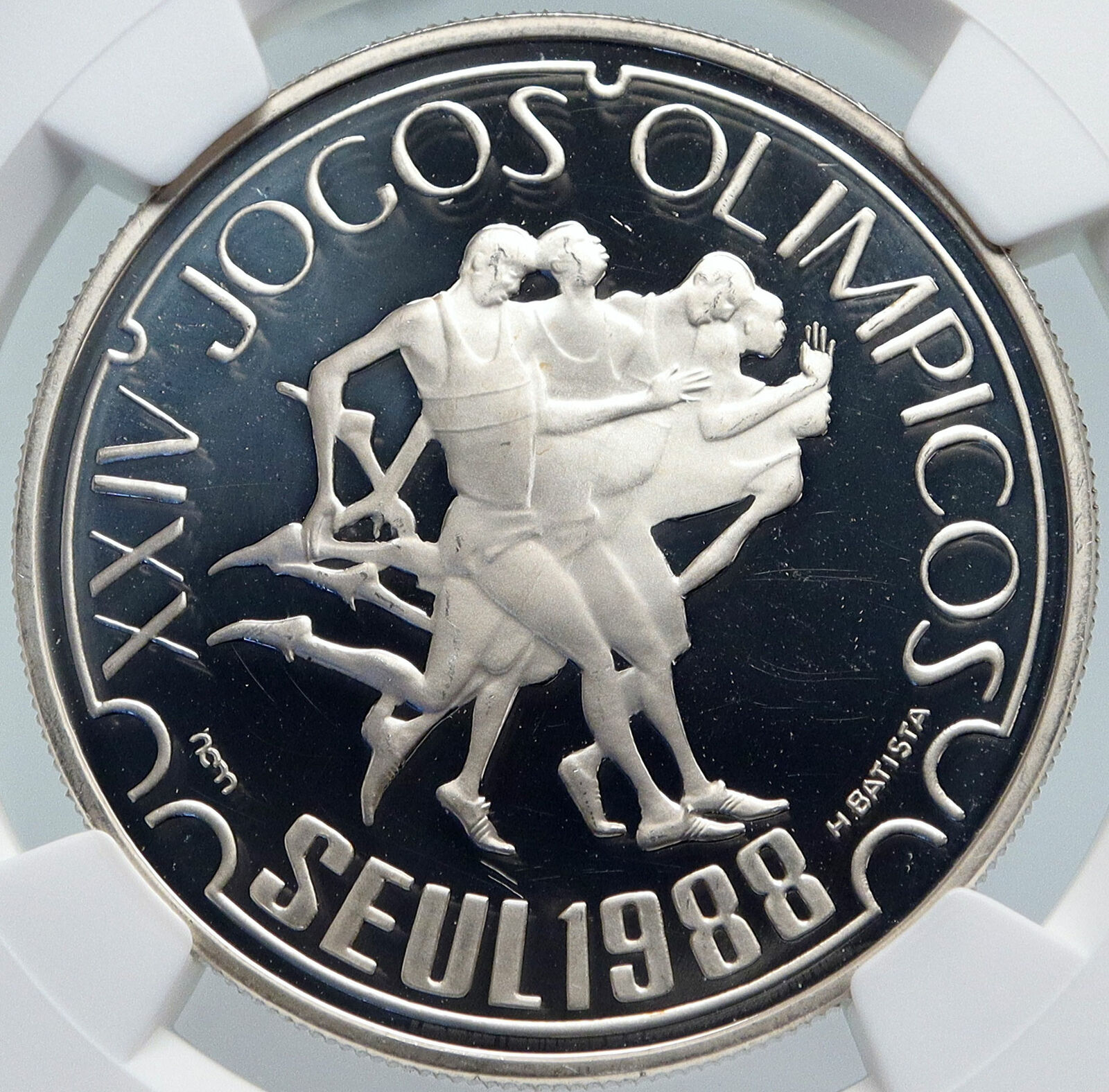|
Portugal – 550th Anniversary – Discovery of Azores
1989 Proof Silver 100 Escudos 33mm (20.84 grams) 0.925 Silver (0.6245 oz. ASW)
Reference: KM# 648a
REPUBLICA PORTUGUESA ·100$00, Portuguese coat of arms at right within design.
1439-1989· ARQUIPÉLAGO DOS ACORES 1427-1452, Caravel with lateen sails to the left, and stars within design. Below the boat the dates of the discoveries of the first (Santa Maria 1427) and last Corvo and Flores 1452) islands. Both Portugueses and Flemish navigators were involved. Above, 1439 states for the first official map of the archipelago, and the Authorization by Infante Enrique for the colonization (2 July 1439).
You are bidding on the exact item pictured, provided with a Certificate of Authenticity and Lifetime Guarantee of Authenticity.
 The Azores, officially the Autonomous Region of the Azores (Região Autónoma dos Açores), is one of the two autonomous regions of Portugal (along with Madeira). It is an archipelago composed of nine volcanic islands in the Macaronesia region of the North Atlantic Ocean, about 1,360 km (850 mi) west of continental Portugal, about 1,500 km (930 mi) west of Lisbon, in continental Portugal, about 1,500 km (930 mi) northwest of Morocco, and about 2,500 km (1,600 mi) southeast of Newfoundland, Canada. The Azores, officially the Autonomous Region of the Azores (Região Autónoma dos Açores), is one of the two autonomous regions of Portugal (along with Madeira). It is an archipelago composed of nine volcanic islands in the Macaronesia region of the North Atlantic Ocean, about 1,360 km (850 mi) west of continental Portugal, about 1,500 km (930 mi) west of Lisbon, in continental Portugal, about 1,500 km (930 mi) northwest of Morocco, and about 2,500 km (1,600 mi) southeast of Newfoundland, Canada.
A small number of alleged hypogea, earthen structures carved into rocks that were used for burials, have been identified on the islands of Corvo, Santa Maria and Terceira by Portuguese archaeologist Nuno Ribeiro, who speculated that they might date back 2000 years, implying a human presence on the island before the Portuguese. These kinds of structures have been used in the Azores to store cereals, however, and suggestions by Ribeiro that they might be burial sites are unconfirmed. Detailed examination and dating to authenticate the validity of these speculations is lacking, thus it is unclear whether these structures are natural or man-made and whether they predate the 15th-century Portuguese colonization of the Azores.
Discovery
 The islands were known in the fourteenth century, and parts of them appear in the Catalan Atlas. In 1427, a captain sailing for Prince Henry the Navigator, possibly Gonçalo Velho, may have rediscovered the Azores, but this is not certain. In Thomas Ashe’s 1813 work, A History of the Azores, the author identified a Fleming, Joshua Vander Berg of Bruges, who made landfall in the archipelago during a storm on his way to Lisbon. He stated that the Portuguese explored the area and claimed it for Portugal. Other stories note the discovery of the first islands (São Miguel Island, Santa Maria Island and Terceira Island) by sailors in the service of Henry the Navigator, although there are few documents to support the claims. The islands were known in the fourteenth century, and parts of them appear in the Catalan Atlas. In 1427, a captain sailing for Prince Henry the Navigator, possibly Gonçalo Velho, may have rediscovered the Azores, but this is not certain. In Thomas Ashe’s 1813 work, A History of the Azores, the author identified a Fleming, Joshua Vander Berg of Bruges, who made landfall in the archipelago during a storm on his way to Lisbon. He stated that the Portuguese explored the area and claimed it for Portugal. Other stories note the discovery of the first islands (São Miguel Island, Santa Maria Island and Terceira Island) by sailors in the service of Henry the Navigator, although there are few documents to support the claims.
Although it is commonly said that the archipelago received its name from açor (goshawk in Portuguese), a common bird at the time of discovery, it is unlikely that the bird nested or hunted on the islands.
Settlement
There were no large animals on Santa Maria, so after its discovery and before settlement began, sheep were let loose on the island to supply future settlers with food. Settlement did not take place right away, however. Portuguese people weren’t very interested in living on an isolated archipelago so far from civilization. Gonçalo Velho Cabral patiently gathered resources and settlers for the next three years (1433-1436), however, and sailed to establish colonies, first on Santa Maria and then on São Miguel. Settlers cleared bush and rocks to plant crops: grain, grape vines, sugar cane, and other plants suitable for local use and of commercial value. They brought domesticated animals, such as chickens, rabbits, cattle, sheep, goats, and pigs, and built houses and established villages.
 The archipelago was largely settled from mainland Portugal. Portuguese settlers came from the provinces of Algarve, Minho, Alentejo and Ribatejo as well as Madeira. São Miguel was first settled in 1449, the settlers – mainly from the Estremadura, Alto Alentejo and Algarve areas of mainland Portugal, under the command of Gonçalo Velho Cabral – landed at the site of modern-day Povoação. Many of the early settlers were Portuguese Sephardic Jews who were banished/exiled there by the inquisition on mainland Portugal – many had well known Sephardic surnames such as: Pereira, Oliveira, Cardoso, Pimentel, Pinto, Rodrigues, Mendes, or Nunes. The archipelago was largely settled from mainland Portugal. Portuguese settlers came from the provinces of Algarve, Minho, Alentejo and Ribatejo as well as Madeira. São Miguel was first settled in 1449, the settlers – mainly from the Estremadura, Alto Alentejo and Algarve areas of mainland Portugal, under the command of Gonçalo Velho Cabral – landed at the site of modern-day Povoação. Many of the early settlers were Portuguese Sephardic Jews who were banished/exiled there by the inquisition on mainland Portugal – many had well known Sephardic surnames such as: Pereira, Oliveira, Cardoso, Pimentel, Pinto, Rodrigues, Mendes, or Nunes.
In 1522, Vila Franca do Campo, then the capital of the island, was devastated by an earthquake and landslide that killed about 5,000 people, and the capital was moved to Ponta Delgada. The town of Vila Franca do Campo was rebuilt on the original site and today is a thriving fishing and yachting port. Ponta Delgada received its city status in 1546. From the first settlement, the pioneers applied themselves to agriculture and by the 15th century Graciosa exported wheat, barley, wine and brandy. The goods were sent to Terceira largely because of the proximity of the island.
The first reference to the island of São Jorge was made in 1439 but the actual date of discovery is unknown. In 1443 the island was already inhabited but active settlement only began with the arrival of the noble Flemish native Willem van der Haegen. Arriving at Topo, where he lived and died, he became known as Guilherme da Silveira to the islanders. João Vaz Corte-Real received the captaincy of the island in 1483. Velas became a town before the end of the 15th century. By 1490, there were 2,000 Flemings living in the islands of Terceira, Pico, Faial, São Jorge and Flores. Because there was such a large Flemish settlement, the Azores became known as the Flemish Islands or the Isles of Flanders. Prince Henry the Navigator was responsible for this settlement. His sister, Isabel, was married to Duke Philip of Burgundy of which Flanders was a part. There was a revolt against Philip’s rule and disease and hunger became rampant. Isabel appealed to Henry to allow some of the unruly Flemings to settle in the Azores. He granted this and supplied them with the necessary transportation and goods.
The settlement of the then-unoccupied islands started in 1439 with people mainly from the continental provinces of Algarve and Alentejo. In 1583, Philip II of Spain, as king of Portugal, sent his fleet to clear the Azores of a combined multinational force of adventurers, mercenaries, volunteers and soldiers who were attempting to establish the Azores as a staging post for a rival pretender to the Portuguese throne. Following the success of his fleet at the Battle of Ponta Delgada captured enemies were hanged from yardarms, as they were considered pirates by Philip II. Opponents receiving the news variously portrayed Philip II as a despot or “Black Legend”; the sort of insult widely made against contemporary monarchs engaged in aggressive empire building and the European Wars of Religion. An English raid of the Azores in 1589 successfully plundered some harbouring ships and islands; a repeat eight years later, the Islands Voyage, failed. Spain held the Azores under the “Babylonian captivity” of 1580-1642. In the late 16th century, the Azores and Madeira began to face problems of overpopulation. Spawning from that particular economic problem, some of the people began to emigrate to Brazil.
  Portugal, officially the Portuguese Republic (Portuguese: República Portuguesa), is a country on the Iberian Peninsula, in Southwestern Europe. It is the westernmost country of mainland Europe, being bordered by the Atlantic Ocean to the west and south and by Spain to the north and east. The Portugal-Spain border is 1,214 km (754 mi) long and considered the longest uninterrupted border within the European Union. The republic also includes the Atlantic archipelagos of the Azores and Madeira, both autonomous regions with their own regional governments. Portugal, officially the Portuguese Republic (Portuguese: República Portuguesa), is a country on the Iberian Peninsula, in Southwestern Europe. It is the westernmost country of mainland Europe, being bordered by the Atlantic Ocean to the west and south and by Spain to the north and east. The Portugal-Spain border is 1,214 km (754 mi) long and considered the longest uninterrupted border within the European Union. The republic also includes the Atlantic archipelagos of the Azores and Madeira, both autonomous regions with their own regional governments.
 The territory of modern Portugal has been continuously settled, invaded and fought over since prehistoric times. The Pre-Celts, Celts, Phoenicians, Carthaginians and the Romans were followed by the invasions of the Visigothic and the Suebi Germanic peoples, who were themselves later invaded by the Moors. These Muslim peoples were eventually expelled during the Christian Reconquista. Portuguese nationality can be traced back to the creation of the First County of Portugal, in 868. In 1139, Afonso Henriques was proclaimed King of Portugal, thus firmly establishing Portuguese independence, under the Portuguese House of Burgundy. The territory of modern Portugal has been continuously settled, invaded and fought over since prehistoric times. The Pre-Celts, Celts, Phoenicians, Carthaginians and the Romans were followed by the invasions of the Visigothic and the Suebi Germanic peoples, who were themselves later invaded by the Moors. These Muslim peoples were eventually expelled during the Christian Reconquista. Portuguese nationality can be traced back to the creation of the First County of Portugal, in 868. In 1139, Afonso Henriques was proclaimed King of Portugal, thus firmly establishing Portuguese independence, under the Portuguese House of Burgundy.
In the 15th and 16th centuries, under the House of Aviz, which took power following the 1383-85 Crisis, Portugal expanded Western influence and established the first global empire, becoming one of the world’s major economic, political and military powers. During this time, Portuguese explorers pioneered maritime exploration in the Age of Discovery, notably under royal patronage of Prince Henry the Navigator and King João II, with such notable discoveries as Vasco da Gama’s sea route to India (1497-98), Pedro Álvares Cabral’s discovery of Brazil (1500), and Bartolomeu Dias’s reaching of the Cape of Good Hope. Portugal monopolized the spice trade during this time, under royal command of the Casa da Índia, and the Portuguese Empire expanded with military campaigns led in Asia, notably under Afonso de Albuquerque, who was known as the “Caesar of the East”.
The destruction of Lisbon in a 1755 earthquake, the country’s occupation during the Napoleonic Wars, the independence of Brazil (1822), and the Liberal Wars (1828-1834), all left Portugal crippled from war and diminished in its world power. After the 1910 revolution deposed the monarchy, the democratic but unstable Portuguese First Republic was established, later being superseded by the “Estado Novo” right-wing authoritarian regime. Democracy was restored after the Portuguese Colonial War and the Carnation Revolution in 1974. Shortly after, independence was granted to all its colonies and East Timor, with the exception of Macau, which was handed over to China in 1999. This marked the end of the longest-lived European colonial empire, leaving a profound cultural and architectural influence across the globe and a legacy of over 250 million Portuguese speakers today.
Portugal is a developed country with a high-income advanced economy and high living standards. It is the 5th most peaceful country in the world, maintaining a unitary semi-presidential republican form of government. It has the 18th highest Social Progress in the world, putting it ahead of other Western European countries like France, Spain and Italy. It is a member of numerous international organizations, including the United Nations, the European Union, the eurozone, OECD, NATO and the Community of Portuguese Language Countries. Portugal is also known for having decriminalized the usage of all common drugs in 2001, the first country in the world to do so. However, the sale and distribution of these drugs is still illegal in Portugal.
|





 The Azores, officially the Autonomous Region of the Azores (Região Autónoma dos Açores), is one of the two autonomous regions of Portugal (along with Madeira). It is an archipelago composed of nine volcanic islands in the Macaronesia region of the North Atlantic Ocean, about 1,360 km (850 mi) west of continental Portugal, about 1,500 km (930 mi) west of Lisbon, in continental Portugal, about 1,500 km (930 mi) northwest of Morocco, and about 2,500 km (1,600 mi) southeast of Newfoundland, Canada.
The Azores, officially the Autonomous Region of the Azores (Região Autónoma dos Açores), is one of the two autonomous regions of Portugal (along with Madeira). It is an archipelago composed of nine volcanic islands in the Macaronesia region of the North Atlantic Ocean, about 1,360 km (850 mi) west of continental Portugal, about 1,500 km (930 mi) west of Lisbon, in continental Portugal, about 1,500 km (930 mi) northwest of Morocco, and about 2,500 km (1,600 mi) southeast of Newfoundland, Canada.  The islands were known in the fourteenth century, and parts of them appear in the Catalan Atlas. In 1427, a captain sailing for Prince Henry the Navigator, possibly Gonçalo Velho, may have rediscovered the Azores, but this is not certain. In Thomas Ashe’s 1813 work, A History of the Azores, the author identified a Fleming, Joshua Vander Berg of Bruges, who made landfall in the archipelago during a storm on his way to Lisbon. He stated that the Portuguese explored the area and claimed it for Portugal. Other stories note the discovery of the first islands (São Miguel Island, Santa Maria Island and Terceira Island) by sailors in the service of Henry the Navigator, although there are few documents to support the claims.
The islands were known in the fourteenth century, and parts of them appear in the Catalan Atlas. In 1427, a captain sailing for Prince Henry the Navigator, possibly Gonçalo Velho, may have rediscovered the Azores, but this is not certain. In Thomas Ashe’s 1813 work, A History of the Azores, the author identified a Fleming, Joshua Vander Berg of Bruges, who made landfall in the archipelago during a storm on his way to Lisbon. He stated that the Portuguese explored the area and claimed it for Portugal. Other stories note the discovery of the first islands (São Miguel Island, Santa Maria Island and Terceira Island) by sailors in the service of Henry the Navigator, although there are few documents to support the claims.  The archipelago was largely settled from mainland Portugal. Portuguese settlers came from the provinces of Algarve, Minho, Alentejo and Ribatejo as well as Madeira. São Miguel was first settled in 1449, the settlers – mainly from the Estremadura, Alto Alentejo and Algarve areas of mainland Portugal, under the command of Gonçalo Velho Cabral – landed at the site of modern-day Povoação. Many of the early settlers were Portuguese Sephardic Jews who were banished/exiled there by the inquisition on mainland Portugal – many had well known Sephardic surnames such as: Pereira, Oliveira, Cardoso, Pimentel, Pinto, Rodrigues, Mendes, or Nunes.
The archipelago was largely settled from mainland Portugal. Portuguese settlers came from the provinces of Algarve, Minho, Alentejo and Ribatejo as well as Madeira. São Miguel was first settled in 1449, the settlers – mainly from the Estremadura, Alto Alentejo and Algarve areas of mainland Portugal, under the command of Gonçalo Velho Cabral – landed at the site of modern-day Povoação. Many of the early settlers were Portuguese Sephardic Jews who were banished/exiled there by the inquisition on mainland Portugal – many had well known Sephardic surnames such as: Pereira, Oliveira, Cardoso, Pimentel, Pinto, Rodrigues, Mendes, or Nunes. 
 Portugal, officially the Portuguese Republic (Portuguese: República Portuguesa), is a country on the Iberian Peninsula, in Southwestern Europe. It is the westernmost country of mainland Europe, being bordered by the Atlantic Ocean to the west and south and by Spain to the north and east. The Portugal-Spain border is 1,214 km (754 mi) long and considered the longest uninterrupted border within the European Union. The republic also includes the Atlantic archipelagos of the Azores and Madeira, both autonomous regions with their own regional governments.
Portugal, officially the Portuguese Republic (Portuguese: República Portuguesa), is a country on the Iberian Peninsula, in Southwestern Europe. It is the westernmost country of mainland Europe, being bordered by the Atlantic Ocean to the west and south and by Spain to the north and east. The Portugal-Spain border is 1,214 km (754 mi) long and considered the longest uninterrupted border within the European Union. The republic also includes the Atlantic archipelagos of the Azores and Madeira, both autonomous regions with their own regional governments. The territory of modern Portugal has been continuously settled, invaded and fought over since prehistoric times. The Pre-Celts, Celts, Phoenicians, Carthaginians and the Romans were followed by the invasions of the Visigothic and the Suebi Germanic peoples, who were themselves later invaded by the Moors. These Muslim peoples were eventually expelled during the Christian Reconquista. Portuguese nationality can be traced back to the creation of the First County of Portugal, in 868. In 1139, Afonso Henriques was proclaimed King of Portugal, thus firmly establishing Portuguese independence, under the Portuguese House of Burgundy.
The territory of modern Portugal has been continuously settled, invaded and fought over since prehistoric times. The Pre-Celts, Celts, Phoenicians, Carthaginians and the Romans were followed by the invasions of the Visigothic and the Suebi Germanic peoples, who were themselves later invaded by the Moors. These Muslim peoples were eventually expelled during the Christian Reconquista. Portuguese nationality can be traced back to the creation of the First County of Portugal, in 868. In 1139, Afonso Henriques was proclaimed King of Portugal, thus firmly establishing Portuguese independence, under the Portuguese House of Burgundy.




